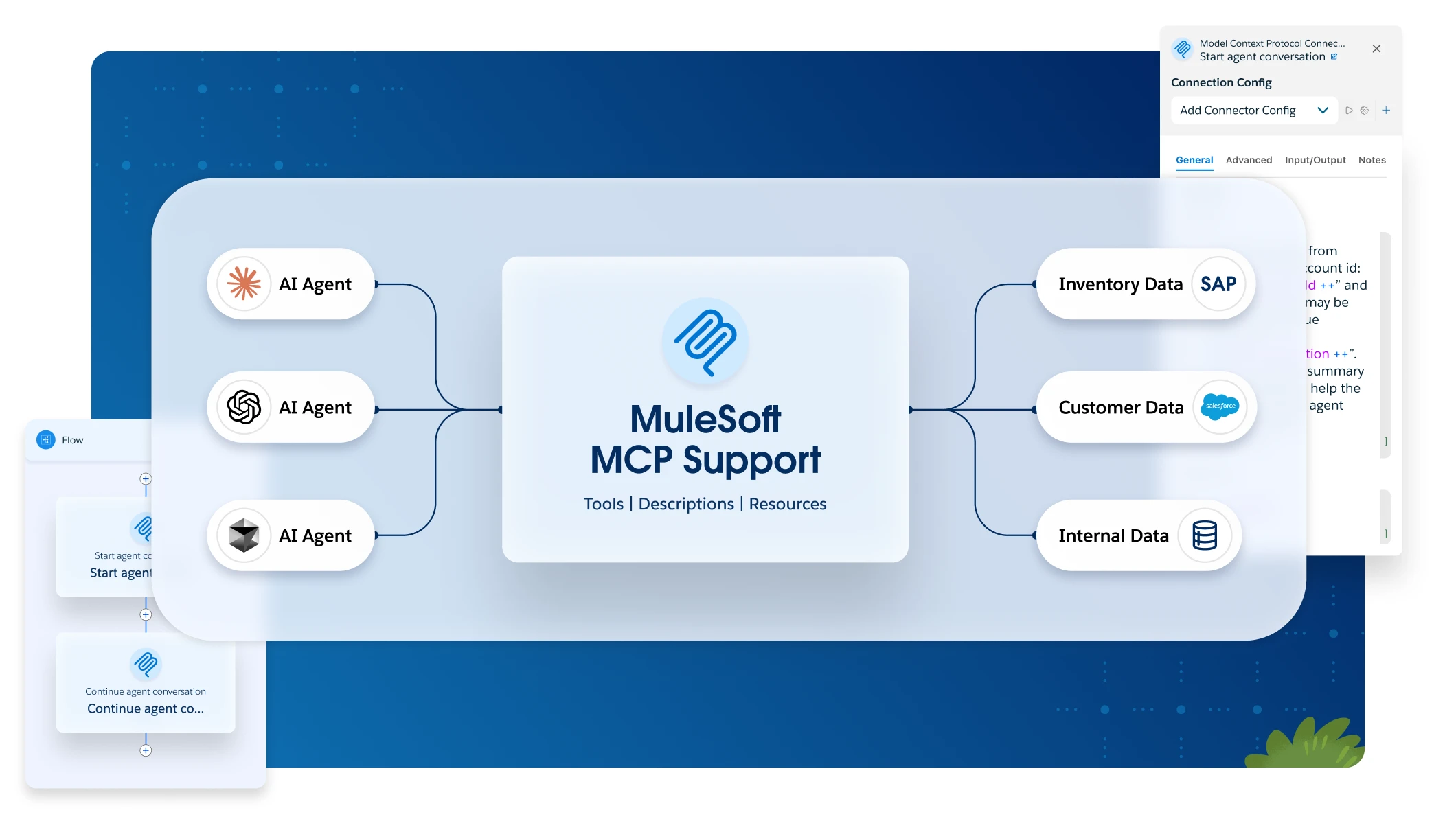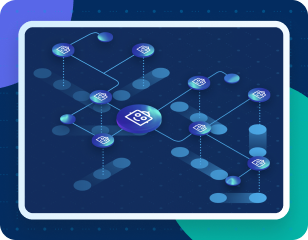Imagine a scenario where a customer’s order is delayed due to bad weather, and they’re on the verge of canceling their order. Enter Agentforce for Service, powered by MuleSoft, which can handle low-touch interactions autonomously and also make strategic decisions to retain customer satisfaction and revenue.
By seamlessly integrating with third-party systems like logistics and inventory management, MuleSoft extends Agentforce capabilities for order management, ensuring that every interaction is not just efficient but also personalized and proactive. In this article, we’ll explore how this dynamic duo can revolutionize your service processes and keep your customers coming back for more.
Autonomous AI: Agentforce service agents
Having a hybrid workforce of AI and human agents is rapidly becoming the norm when every business, software, and brand requires customer service to communicate with end-users about issues, offerings, and more.
Service Cloud brings this vision to life by enabling seamless collaboration between humans and autonomous AI agents. This partnership ensures that every customer interaction is efficient, personalized, and proactive, from the first touch to the final resolution.
Adding in Agentforce for Service, organizations can optimize their service processes, allowing AI agents to handle low-touch interactions while human agents focus on high-touch tasks that require a more sophisticated approach. This division of labor increases operational efficiency and also improves the overall customer experience.
These AI agents are designed to handle a wide range of customer service tasks, from simple to complex, with sophisticated reasoning capabilities. They are trained to provide accurate and relevant answers based within the organization’s set parameters.
As AI technology progresses, so will Agentforce for Service capabilities. It will have the capacity to manage intricate tasks independently, reducing the necessity for human intervention, and this will further optimize the order management process, enabling your human agents to concentrate on more pressing, high-touch matters.
For example, in the case of a delayed order, an autonomous agent can take the initiative to engage with the customer, providing real-time updates and potential alternatives, thus averting order cancellations.
The true value of agents comes from action
The potential of autonomous service agents is best realized when their capacity for action is emphasized over their role as mere informants. While a chatbot can address rudimentary queries, the distinction lies in the last-mile automation that Agentforce for Service embodies. This translates to AI agents being able to execute tasks that tangibly affect the customer experience, such as updating order statuses, managing returns, and even initiating refunds.
This proactivity elevates Agentforce beyond the realm of a standard FAQ chatbot, positioning it as a robust instrument for customer service.
The execution layer of Agentforce for Service is the critical component that ensures AI agents can communicate with customers and execute actions in your business systems. For example, if a customer contacts the service about a delayed order, the AI agent can automatically check the logistics system for real-time updates, communicate these updates to the customer, and even offer a discount or alternative shipping options to mitigate the inconvenience.
This seamless integration and execution of tasks not only enhances the customer experience but also reduces the burden on human agents, allowing them to focus on more complex and high-touch interactions.
Without this capacity for action, Agentforce would be no more than an advanced FAQ chatbot, merely dispensing static responses. By interfacing with MuleSoft, Agentforce is empowered to access and manage data from a multitude of systems, ensuring that each interaction is both informative and actionable.
This functionality is especially critical in the domain of order management, where the swiftness and accuracy of updates can determine the outcome of a sale.
Order management: A service journey
Building upon the foundation of autonomous service agents, consider a scenario that exemplifies the efficacy of Agentforce for Service.
Picture a customer who contacts your service team to express concern over a delayed order. Within the Salesforce ecosystem, a service agent is established, ready to respond to a spectrum of inquiries, from order management to frequently asked questions and sales pipeline management. The customer’s query triggers the service agent to initiate a process that will resolve the issue.
When the customer asks about their order, the agent begins by looking at its order management actions. These actions are based on a set of instructions that guide the agent through the process of fulfilling the user request. For example, one of the agent’s tasks is to try to retain revenue in the event of a cancellation by offering a discount on an alternative product. The agent looks up the order and sees that there is a delay due to bad weather at the warehouse. It tells the customer about the delay and asks if they would like to cancel the order.
Recognizing the potential loss of revenue, the agent refers to its instructions and the available actions in its order management collection. It decides to recommend an alternative product, complete with a discount, to mitigate the customer’s inconvenience and reduce the likelihood of a lost sale.
This decision is made based on the context of the conversation and the agent’s training in customer retention strategies. The customer is presented with a compelling offer, which not only addresses their immediate concern but also keeps them engaged with the brand.
This scenario is a fully self-contained Agentforce story that unfolds within the Salesforce internal ecosystem. Agentforce makes it incredibly easy to implement such use cases, streamlining the process of addressing customer concerns and retaining revenue.
However, there are broader implications on third-party systems such as logistics, inventory management, and ERP. These systems, not traditionally part of the Salesforce ecosystem, require third-party app integrations and IT investments to ensure seamless operations. But with MuleSoft, these integrations become not only feasible but also efficient, enhancing the overall service journey.
Agents’ role in saving orders with MuleSoft for Agentforce Service Cloud
The extended power of Agentforce for Service is in the integration with MuleSoft. The MuleSoft for Agentforce: API Catalog and Knowledge Center provide the means to connect Agentforce to a wide variety of external systems, making it a versatile order management tool. However, this integration is not a one-size-fits-all solution. It requires collaboration between MuleSoft developers and Salesforce administrators to ensure that the Agentforce for Service is tailored to the specific business needs of the organization.
To illustrate how this collaboration can save orders and improve customer satisfaction, let’s walk through a real-world example. Imagine a warehouse in New York City is unable to fulfill an order on time due to severe weather. With MuleSoft for Agentforce, the agent’s primary goal is to retain the order and keep the customer engaged.
The agent begins by checking the inventory systems of nearby stores. Although the New York City locations are out of stock, the agent finds available inventory in Jersey City. The agent then offers to hold the item for pickup at the Jersey City location. This solution is ideal because it minimizes the number of stores the item would need to be shipped to and ensures the customer receives their order with minimal delay.
Yet if the customer is disinclined to journey to Jersey City, the agent has an alternative. Acknowledging that all home delivery options are managed by the warehouse, the agent investigates the potential for an inter-store inventory transfer.
Through the use of MuleSoft’s integration capabilities, the agent can seamlessly access and update the inventory management system to initiate the transfer.
The agent then presents this option to the customer, detailing that the item can be delivered to the nearest store for pickup, expediting the process. Should the customer assent, the agent promptly generates the inventory movement request and updates the order status in real-time, ensuring a transparent and efficient procedure.
This case underscores the pivotal function of MuleSoft in augmenting the capabilities of Agentforce for Service. By facilitating access to real-time data and external systems, MuleSoft equips these agents to make judicious decisions and take proactive measures.
Whether it’s inventory checks, holding items for pickup, or coordinating inter-store transfers, MuleSoft for Agentforce allows agents to operate seamlessly across platforms, simplifying the order management process and ultimately salvaging orders that might otherwise be lost.
Other industry applications
MuleSoft for Agentforce: Service Cloud can streamline orders and elevate customer engagement across distinct industries. Whether it’s healthcare and life sciences, manufacturing, financial services, or retail and consumer goods, each industry presents specific needs that can be met with the combined expertise of AI agents powered by MuleSoft.
Healthcare, life sciences, and medtech
When it comes to healthcare, timely and accurate order management is critical. Delays and disruptions can affect the level of care patients receive and ultimately adversely affect both patient outcomes and satisfaction.
MuleSoft for Agentforce: Service Cloud can integrate with logistics platforms and real-time tracking systems to provide the most accurate updates on supplies and orders. By doing this, clinical trial studies can proceed without delay and clinicians have the items they need to best serve patients,
For example, with MuleSoft for Agentforce: Service Cloud, if a shipment bound for a research facility is delayed due to a storm, the AI agent can automatically inform the organization, offer different delivery options, and even arrange for a rescheduled delivery.
Manufacturing
For the manufacturing industry, MuleSoft for Agentforce: Service Cloud can expeditiously retrieve information from the manufacturing system, ensuring a comprehensive status update. With this, the agent can propose solutions, such as accelerated shipping or alternative products, in the event of potential delays in order to ensure that the parts and supplies manufacturers need to get to their customers on time.
Agentforce for Service can help create a seamless, personal shopping experience. Plus, integrating with MuleSoft can enhance this experience by handling a wide range of customer interactions, from order tracking and returns, to personalized product recommendations.
Building a foundation for agents in your service strategy
The integration of MuleSoft with Agentforce for Service creates an opportunity to transform the order management process.
MuleSoft’s advanced API capabilities enable seamless connections with third-party systems, such as logistics, inventory management, and ERP, ensuring that every customer interaction is both efficient and personalized. This integration not only streamlines order processing and reduces errors but also enhances customer satisfaction by providing real-time updates and proactive solutions.
Whether it’s a delayed shipment, a custom order, or a product return, MuleSoft for Agentforce: Service Cloud can handle it all with precision and speed. Learn more about MuleSoft for Agentforce to discover how enterprises can realize a level of operational efficiency that distinguishes them in the current competitive landscape.









